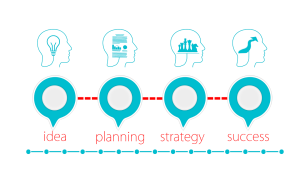Professional development plans can be extremely useful in helping you achieve your career goals. It can provide you with a guide to achieve your short-term goals, and long-term goals, and boost professional growth.
Whether you’re aiming to complete a crucial project, secure a raise, or switch careers, a professional development strategy can set you on the path to success. To kickstart this journey, consider taking the HIGH5 strengths assessment. This powerful tool helps you identify your unique strengths, providing a solid foundation for your professional development plan. By understanding your innate talents, you can align your career goals with your natural abilities, making your professional growth more targeted and effective.
On the other hand, a poorly implemented strategy could cost you time and money. It could lower your motivation levels and decrease your morale.
In this article, we will describe the proper way to set professional goals and develop a professional development strategy while avoiding some of the commonly made career development mistakes.
What is a Professional Development Plan (PDP)?
Professional development plans otherwise referred to as PDPs, are essentially comprised of a list of steps that help you achieve your professional goals.
It helps you understand how you can attain both your short- and long-term goals, such as finding a mentor or taking some education courses. Creating this plan can be especially useful to job seekers.

This is so because through defining goals in your PDP, you will understand what you truly want in a job or employer. PDPs can be developed in a number of formats.
It can be a simple Google Doc, or it can be a more complex, yet structured, table with columns. To find the best format for you, think about what you would like your future professional life to look like.
See which goals help achieve the goals that contribute to your ideal future. Anytime you achieve a new milestone, add that to your PDP. Continuously updating your plan will help you set new goals and contribute to your skill-building, thus leading to professional growth.
How to Create a Professional Development Plan in 5 Steps
A 5-Step Professional Development Plan may seem rushed at first, but in fact, it can only take 5 steps to create a solid goal and great overall development plan.
The First Step: Self-assessment or Career test
The first step in creating a professional development plan is a thorough self-assessment. This involves evaluating your career interests, knowledge, experience, and skills. To gain a comprehensive understanding of your professional strengths, consider taking the HIGH5 strengths assessment. This scientifically-backed test goes beyond traditional skill evaluations, revealing your unique talents and how they can be leveraged in your career. By identifying your top five strengths, you’ll have a clearer picture of where you currently stand in your professional development journey and how to capitalize on your natural abilities for future growth.
To get some ideas about which career paths to look at, take the job aptitude test.
Determining your skills can help you identify areas of weakness as well as new ways to utilize your strengths. Try your best to identify your strengths or transferable skills, which are the skills many employers look for.
Consider developing communication skills, teamwork, leadership, and technological skills.
The Second Step: Goals
When setting goals for your professional development plan, it’s crucial to ensure they are SMART: specific, measurable, attainable, realistic, and time-bound. SMART goals are easy to track, making your PDP easier to update. To make your goals even more effective, consider aligning them with your innate strengths. The HIGH5 strengths assessment can provide valuable insights into your natural talents, allowing you to set goals that leverage these strengths. For instance, if the assessment reveals that one of your top strengths is ‘Strategic Thinker,’ you might set a goal to lead a complex project that requires long-term planning. By constructing goals that play to your strengths and breaking them into manageable chunks, you’ll find them more achievable and motivating.
List your goals in order of importance so that you understand what needs to be worked on immediately. Categorize your goals into three main sections: short-term (within a year), medium-term (one to two years), and long-term (at least three to five years).
The Third Step: Strategies
A professional development strategy depends on the goals that encompass it. Include a variety of strategies into your plan, including experimental learning, learning from others, education, and learning from your mistakes.
Most of your strategies should be experimental. Doing so exposes you to hands-on experiences while developing your skill sets. For instance, someone who is immensely interested in biology should try volunteering in a biology lab for the summer.
Think about how much education is needed to achieve your goals. Consider finding potential mentors to assist you and explore potential opportunities at your current workplace.
The Fourth Step: Resources
Resources are people or places that help you grow professionally. The following are a few examples of popular professional resources:
Education institutions.
These settings offer conferences and courses in a multitude of fields. They will likely offer certificates or degrees, which display your knowledge on a specific topic. You could even try taking classes online or attending a community college to minimize debt.
Webinars.
You may be able to find the perfect mentor in a webinar. They could share valuable advice on a specific topic. The benefit of webinars is that you can join from anywhere. You can find a webinar for virtually any career interest.
Professional events.
Many associations offer memberships within a particular industry. Using a membership, you can connect with other individuals with similar career interests. As your professional network grows, so do the opportunities for your career growth.
The Fifth Step: Timelines
Consistently reevaluate your professional development plan. Change it over time so it reflects your constantly evolving goals and desires.
Good times to change your PDP are when you achieve a milestone, update your strategy, or change your goals.
Template & Example of PDP
Here is a link to the PDP template which you can download and use as you want.
Here is a professional development plan example that can assist you in developing your unique plan:
Self-assessment
- Improve your time management skills and become a better leader.
- Build upon your existing people skills.
- Improve your persuasion and negotiation skills.
Goals
- Increase your salary by 20% in the next 6 months.
- Get promoted to a managerial role.
- Gain more responsibilities and duties at work.
Strategies
- Find a management mentor.
- Find new responsibilities at your current job.
- Complete a leadership webinar.
- Complete at least three courses on accounting at a community college.
- Learn a specific career skill.
Resources
- Finding a local entrepreneurial community or center.
- Videos on multiple communication styles.
- Training centers focused on career development.
Timeline
- Month one: lead a small team within your current organization.
- Month two: find a mentor for advice.
- Month three: start leadership and project management courses.
- Year one: get promoted to a senior position.
- Year five: start your own business and lead.
Why is Professional Development Plan Important & List of Benefits
Truthfully, many people are not fully invested in their careers. Taking advantage of your opportunities by starting a PDP will set you further ahead of your peers and give you a competitive advantage over your colleagues.
Additionally, PDPs can make goal-setting far easier and more attainable. Consider some of the following other benefits of a professional development strategy.
List of 6 Benefits
1. Expand your knowledge basis.
Professional Development Plans often involve exploring educational opportunities, finding mentors, or joining programs. This exposure to new ideas and experiences not only increases your knowledge but also provides unique perspectives. To maximize these benefits, consider incorporating the HIGH5 strengths assessment into your PDP. By understanding your top five strengths, you can tailor your development activities to areas where you have natural talent. For example, if ‘Empathizer’ is one of your strengths, you might focus on mentorship programs or leadership courses that allow you to leverage this ability. This strengths-based approach ensures that your professional development is not just about acquiring new skills, but about honing and applying your innate talents in ways that accelerate your career growth.

2. Boosts your confidence and credibility.
The increase in experience will also correlate with more confidence. Nobody is confident if they are missing key strengths and skills in their career. Courses, education, and opportunities increase confidence through finding new skills.
3. Increases earning potential and makes you more attractive to employers.
Credentials, such as degrees and certificates, are often included in development plans and they contribute to an individual’s value as an employee. Those with the right skills are far more likely to be hired than those who do not pay much attention to their career development.
4. Provides you with networking opportunities.
Workshops, conferences, incubators, and other events can be a great place to meet like-minded individuals within your industry. These connections could be immensely useful in your career. This is especially true if you ever need to change your career or find a mentor.
5. Encourages strength and weakness exploration.
PDPs can force you to be honest with yourself. You will likely discover your key strengths and weaknesses and could take action to improve your weaknesses and boost your strengths.
6. Makes career changes smoother.
If you are considering a major career change, gaining skills in that new industry will make the transition less challenging. You can take the HIGH5’s career change assessment to get a better view of your new potential careers.
Pro Tip From HIGH5
Use your HIGH5 strengths to create a unique value proposition for yourself. Identify how your specific combination of strengths sets you apart in your field. Then, actively seek out roles or projects where this unique strength profile can make a significant impact, increasing your value to your organization or industry.
You can also take a look at our latest research on career change statistics, which can help you with your career decisions.
Professional Development Plan For Students
Start thinking about your career early on. If you start crafting a professional development plan as a student, you will be far ahead of your peers.
Start with analyzing your passions and identifying what specifically you would like to achieve in the future. As a young person, mentors and education are especially important.
This does not necessarily mean you must attend college or get a degree; your education can come from internships or volunteering if those suit your goals best.
One example of what to include in your PDP: is long-term goals, education goals and plans, mentors, and support systems.
The Individual Professional Development Plan
This is a particular type of development plan that focuses on skills and competencies that contribute to both an organization’s and an individual’s success. It outlines an action plan that can help you build career skills.
It involves setting goals and improving oneself. Often, the individual professional development plan centers around five core principles.
This includes integrated content (pedagogy), active learning, individualistic learning, mentoring and coaching, as well as coherent policies and standards. Include all five of these features in your development plan.
How to Measure Goals in a Professional Development Plan
There are a variety of ways to measure the goal development that encompasses your PDP. First, measure your starting skill levels before setting goals by taking a pre-assessment.
Over time, follow the strategic plan you have created for yourself and measure your progress by taking the same assessment a few months later. Then, see how much you improved.
The SMART goal method can also help you measure your progress. If your original goal is specific, measuring your success becomes simpler.
For instance, if you set a goal of attaining 25% more clients each week, continuously evaluate how many clients you attain weekly and see how close that number is to your goal.
Sometimes, asking for someone else’s feedback can help you clearly evaluate your goal progression. They can help you understand how well your more difficult-to-measure soft skills are improving.
As your goals and aspirations change, it’s important to change your PDP as well. Keep track of prior versions of the plan so you see how much your career interests and strengths change.
How to Adjust and Improve Professional Development Plan
Every improvement in your career, no matter how small, can lead to significant strides in the future. Your professional development plan is a crucial tool for identifying specific areas for growth and maximizing the efficiency of your efforts. To enhance this process, consider regularly reassessing your strengths using the HIGH5 test. As you develop professionally, your strengths may evolve or new ones may emerge. By staying attuned to these changes through periodic strength assessments, you can continually adjust your PDP to align with your current strengths profile. This dynamic approach ensures that your development activities are always in sync with your natural talents, making your professional growth more targeted and impactful.
Be sure to be specific when writing in your PDP. This way, you can clearly tell whether or not your goals have been met. Another way you can improve your PDP is by taking advantage of the resources around you.
If you have managers or leaders who inspire you, consider volunteering or interning under them. Try to find a mentor in your local community, or join a startup incubator if you have a business idea you would like to pursue.
Education, both formal (college) and informal (webinars or seminars) can also contribute to your PDP. Remember that by accomplishing each goal you set for yourself in your development plan, you are one step closer to achieving your idea of success.
Pro Tip From HIGH5
Schedule a quarterly ‘strengths review’ as part of your PDP adjustment process. Reflect on how effectively you’ve been using each of your top five strengths from the HIGH5 test. For any underutilized strengths, brainstorm new ways to incorporate them into your work in the coming quarter. This ensures your PDP remains dynamic and aligned with your evolving strengths profile.
5 Books for Professional Development Plan
Books can be a great source of inspiration for a professional development journey. Here is a list of some of the best professional development books:
1. Never Eat Alone: And Other Secrets to Success, One Relationship at a Time by Keith Ferrazzi
In this book, Keith Ferrazzi describes the specific process that connects like-minded professionals and builds long-lasting relationships within a network. To him, the best way to build quality relationships is through generosity and helping one’s friends find new connections.
2. Predictable Success: Getting Your Organization on the Growth Track–And Keeping It There by Les McKeown
Les McKeown, an immensely experienced businessman, and consultant uses case studies and industry insights to share the path of growth to aspiring entrepreneurs. He details that the path to success is in part related to market positioning and analyzing management strategies.
3. The New Rules of Work: The Modern Playbook for Navigating Your Career Job, and Waking Up Excited for Work Every Day by Alexandra Cavoulacos and Kathryn Minshew
Alexandra Cavoulacos and Kathryn Minshew, two co-founders of the popular career coaching company Muse, developed a definite guide to achieving success in a constantly changing work environment. They combine quick tips and exercises to show readers how you can establish your company’s core values and maintain a competitive advantage.
4. The 7 Habits of Highly Effective People: Powerful Lessons in Personal Change by Stephen R. Covey
This is a classic professional development book. In it, Covey details how to achieve one’s goals by applying seven basic principles of character and work ethic. He calls these concepts ‘true north’ principles and details these ideas through habit building and becoming less dependent, yet more collaborative.
5. Mindset: The New Psychology of Success by Carol Dweck
Carol Dweck is a world-famous Stanford-trained psychologist. In this guide, Dweck explains the power of mindset and how every single activity we partake in is affected by our mindset. She categorizes mindsets into two main categories: fixed and growth mindsets. She describes how individuals can change their lives and achieve success through a mindset change.
Frequently Asked Questions About Professional Development Plan
How do you Write a Professional Development Plan?
Writing the PDP takes a few steps. It encompasses four main items: goals, resources, strategies, and self-assessment. First, identify how far into your career you currently are. See which strengths and weaknesses you have.
Then, find a mentor to support you. Also, consider getting an education, or at least attending a webinar or seminar. List these activities are goals you would like to achieve in your professional development plan.
Case Studies, Academic, and Research-Based Sources:
- Boud, D., & Garrick, J. (1999). “Understanding Learning at Work.” Routledge. This book explores the concept of workplace learning, relevant to professional development.
- Fullan, M. (2007). “The New Meaning of Educational Change.” Teachers College Press. Fullan’s work is crucial for understanding change management in educational settings, applicable to professional development.
- Honey, P., & Mumford, A. (1992). “The Manual of Learning Styles.” Peter Honey. This manual provides insights into different learning styles, useful for personal development planning.
- Mezirow, J. (1997). “Transformative Learning: Theory to Practice.” New Directions for Adult and Continuing Education. This paper discusses transformative learning theory, relevant for professional development plans.
- Senge, P. M. (1990). “The Fifth Discipline: The Art & Practice of The Learning Organization.” Currency Doubleday.
- Bandura, A. (1977). “Social Learning Theory.” General Learning Press. Bandura’s theory is crucial for understanding how social contexts influence learning and development.







